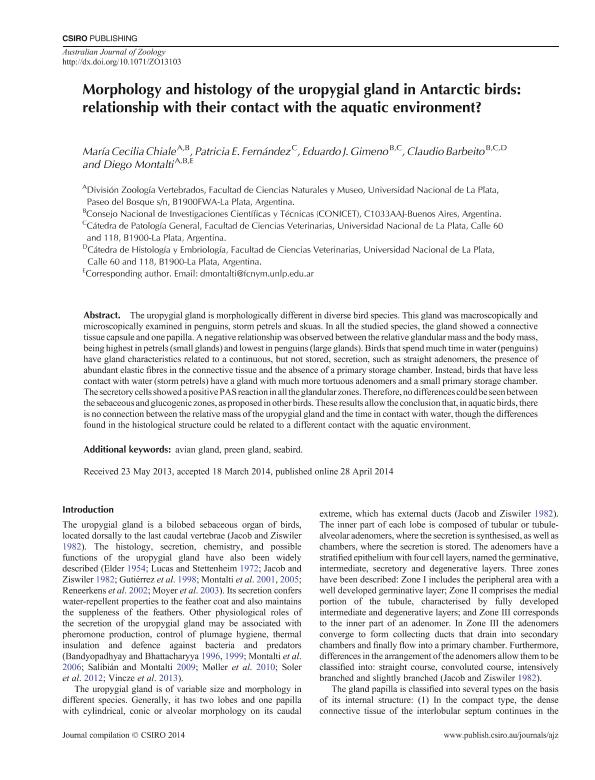Mostrar el registro sencillo del ítem
dc.contributor.author
Chiale, Maria Cecilia

dc.contributor.author
Fernández, Patricia E.
dc.contributor.author
Gimeno, Eduardo Juan

dc.contributor.author
Barbeito, Claudio Gustavo

dc.contributor.author
Montalti, Diego

dc.date.available
2018-01-19T19:08:25Z
dc.date.issued
2014-04
dc.identifier.citation
Chiale, Maria Cecilia; Fernández, Patricia E.; Gimeno, Eduardo Juan; Barbeito, Claudio Gustavo; Montalti, Diego; Morphology and histology of the uropygial gland in Antarctic birds: relationship with their contact with the aquatic environment?; Csiro Publishing; Australian Journal Of Zoology; 62; 2; 4-2014; 157-165
dc.identifier.issn
0004-959X
dc.identifier.uri
http://hdl.handle.net/11336/33999
dc.description.abstract
The uropygial gland is morphologically different in diverse bird species. This gland was macroscopically and microscopically examined in penguins, storm petrels and skuas. In all the studied species, the gland showed a connective tissue capsule and one papilla. A negative relationship was observed between the relative glandular mass and the body mass, being highest in petrels (small glands) and lowest in penguins (large glands). Birds that spend much time in water (penguins) have gland characteristics related to a continuous, but not stored, secretion, such as straight adenomers, the presence of abundant elastic fibres in the connective tissue and the absence of a primary storage chamber. Instead, birds that have less contact with water (storm petrels) have a gland with much more tortuous adenomers and a small primary storage chamber. The secretory cells showed a positive PAS reaction in all the glandular zones. Therefore, no differences could be seen between the sebaceous and glucogenic zones, as proposed in other birds. These results allow the conclusion that, in aquatic birds, there is no connection between the relative mass of the uropygial gland and the time in contact with water, though the differences found in the histological structure could be related to a different contact with the aquatic environment.
dc.format
application/pdf
dc.language.iso
eng
dc.publisher
Csiro Publishing

dc.rights
info:eu-repo/semantics/openAccess
dc.rights.uri
https://creativecommons.org/licenses/by-nc-sa/2.5/ar/
dc.subject
Avian Gland
dc.subject
Seabirds
dc.subject
Uropygial Gland
dc.subject.classification
Otras Ciencias Biológicas

dc.subject.classification
Ciencias Biológicas

dc.subject.classification
CIENCIAS NATURALES Y EXACTAS

dc.title
Morphology and histology of the uropygial gland in Antarctic birds: relationship with their contact with the aquatic environment?
dc.type
info:eu-repo/semantics/article
dc.type
info:ar-repo/semantics/artículo
dc.type
info:eu-repo/semantics/publishedVersion
dc.date.updated
2018-01-16T18:24:24Z
dc.journal.volume
62
dc.journal.number
2
dc.journal.pagination
157-165
dc.journal.pais
Australia

dc.description.fil
Fil: Chiale, Maria Cecilia. Universidad Nacional de La Plata. Facultad de Ciencias Naturales y Museo. División Zoología de Vertebrados; Argentina. Consejo Nacional de Investigaciones Científicas y Técnicas; Argentina
dc.description.fil
Fil: Fernández, Patricia E.. Universidad Nacional de La Plata. Facultad de Ciencias Veterinarias; Argentina
dc.description.fil
Fil: Gimeno, Eduardo Juan. Universidad Nacional de La Plata. Facultad de Ciencias Veterinarias; Argentina. Consejo Nacional de Investigaciones Científicas y Técnicas; Argentina
dc.description.fil
Fil: Barbeito, Claudio Gustavo. Universidad Nacional de La Plata. Facultad de Ciencias Veterinarias; Argentina. Consejo Nacional de Investigaciones Científicas y Técnicas; Argentina
dc.description.fil
Fil: Montalti, Diego. Universidad Nacional de La Plata. Facultad de Ciencias Naturales y Museo. División Zoología de Vertebrados; Argentina. Consejo Nacional de Investigaciones Científicas y Técnicas; Argentina
dc.journal.title
Australian Journal Of Zoology

dc.relation.alternativeid
info:eu-repo/semantics/altIdentifier/doi/http://dx.doi.org/10.1071/ZO13103
dc.relation.alternativeid
info:eu-repo/semantics/altIdentifier/url/http://www.publish.csiro.au/zo/ZO13103
Archivos asociados
